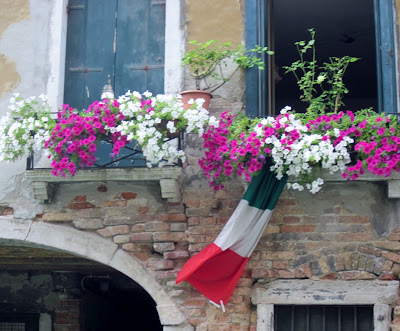 |
| Rowing beneath the Bridge of Sighs |
The
other day my eye caught a blog post on an acquaintance’s Facebook page titled: Top 10 things to do in Venice (riding a
gondola is NOT one of them!). I, along with a few others, left comments;
those that had taken a gondola ride in the past disagreed with the title and agreed
that, well, how could anyone come to Venice and NOT take a ride in a gondola?
Some
of my readers know that I am married to a third generation gondolier, therefore
my comments might come across as a pitch to keep my husband rowing—believe me
he, and his colleagues, don’t need my help. The majority of travelers who come
to Venice do budget for the “once in a lifetime” chance to see Venice from the
perspective only a gondola can provide. And though I skipped a gondola ride on
my first trip to Venice—I was traveling with a girlfriend and we erred in
thinking that a gondola ride was best left to lovey-dovey couples—I’ve since
learned it’s not limited to romance seekers but is indeed the most special way
to explore the lifeline of canals that twist and turn through Venice.
The
Facebook page conversation went back and forth. I made my contributions, maybe
filled with more enthusiasm for Venice and her gondolas than necessary, but
then decided to step aside when a local Venetian’s comment turned to reveal
“hatred” for the category of gondoliers—her
reasons kept to herself as she has the right to do. But hate is a very strong
word, and sentiment. And if instead this remark was applied to say the
restaurant business? “Service at such and such a restaurant was lousy, the food
was worse, therefore I hate all
restaurants.” I wouldn’t have paid much attention to the comment.
Now,
this post is not meant to point fingers at those who disagree with me or who see
the gondoliers—based on their experiences—in a different light than I do. I
know there are locals who are not fond of the gondoliers. This is nothing new.
Even Venice’s cherished Commedia dell’Arte
scribe Carlo Goldoni wrote in the 1700s that the gondoliers, a category he
seemed to be intrigued by, were either loved or hated. Yet, the Facebook
conversation pushed me to ask myself: What would Venice be like without her
gondoliers?
Most
travelers see gondoliers as solely a tourist attraction, while many locals see
them as loud, boisterous, and “they walk around town as if they owned the place”. Both
points of view have a vein of truth and untruth. But I wonder, has either group
ever stopped to think about the contribution the gondoliers make to their city—tourism
aside—and the benefit a few hundred gondolas gliding through the canals bring
to Venice on a daily basis? Without the gondoliers and their gondolas Venice’s
fragile foundation would probably be in a much worse condition. The gondola is
actually a daily deterrent to Moto Ondoso—the
damage made by the wake and the undertow of motorboats to Venice’s foundation.
The gondoliers’ presence on any canal, wide or narrow, force motorboats—often
too much in a hurry to obey speed limits—to slow down. So, their presence alone
helps protect Venice.
 |
| Seahorse ornament on a gondola |
Another
situation that involves gondoliers and their city, and has flared up more recently,
but hasn’t gotten much attention is that a few gondoliers have been threatened,
and not just verbally, by the people who traffic
“designer bags” on the street. Not only are these people selling illegal
goods, some set down their wares and block the gondoliers’ work stations. When
asked to move most do, however some now understand that the city administration
isn’t making the elimination of their illegal trade on Venice’s sidewalks a
priority and have flashed weapons and
broken bottles to threaten the gondoliers who challenge where they decide to
“set up shop”. The gondoliers have formally brought this to the attention of
city officials, the Carabinieri and the local media, not only in defense of
their workplace, but for the respect and love they have for Venice, and above
all to put a stop to the city’s decline. Yet the city administration, so far, has
chosen to look the other way, leaving the actions taken by the
gondoliers—sometimes peaceful, sometimes not—to be brushed off as being
“racially motivated”. Don’t the gondoliers, who are licensed to work at their
given gondola stations, have the right to do so in peace? Or does someone have
to be harmed before the city will address and curb this problem? Doesn’t Venice deserve more respect, if for no other reason than for what she
gives to her residents and all who travel to see her?
In
closing this rather unusual post for my blog, the message I’d like to send is
that the category of gondoliers isn’t made up of angels or demons. They are men of tradition who have families, work hard,
enjoy life, at times exaggerate, and often let a few too many parolacce fly from their lips. As for my
husband, and his many colleagues who have always shown me respect and kindness,
I can testify that they love their city and their jobs, and neither they nor
their category deserve to be hated. I think for all the reasons I’ve stated
above that the city, and its residents, should instead give them a little support.












































